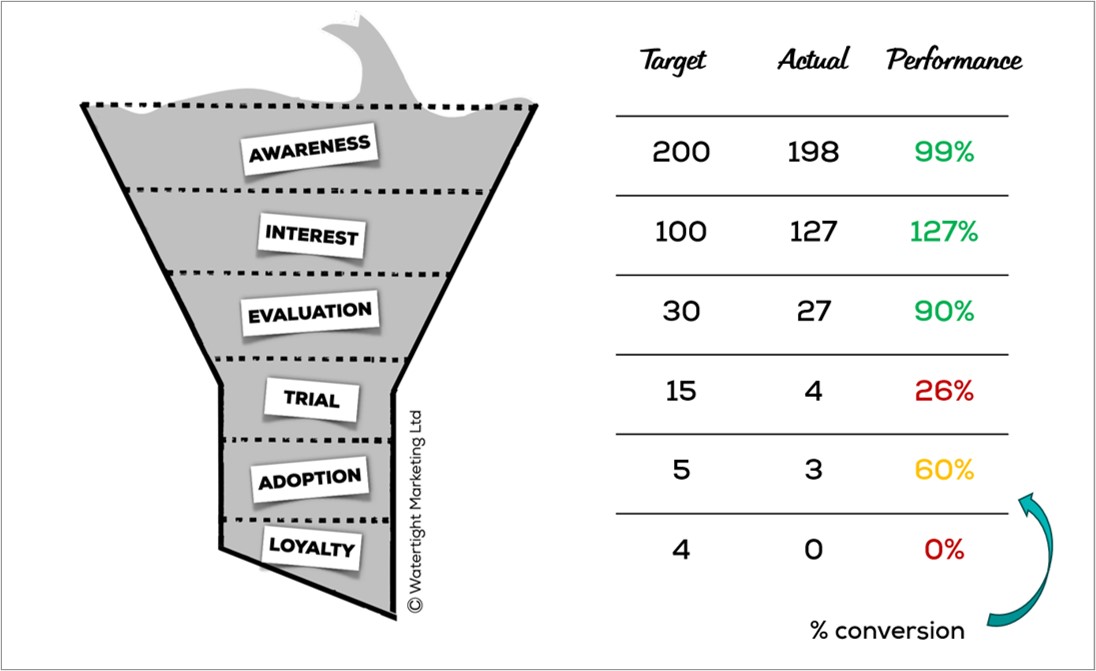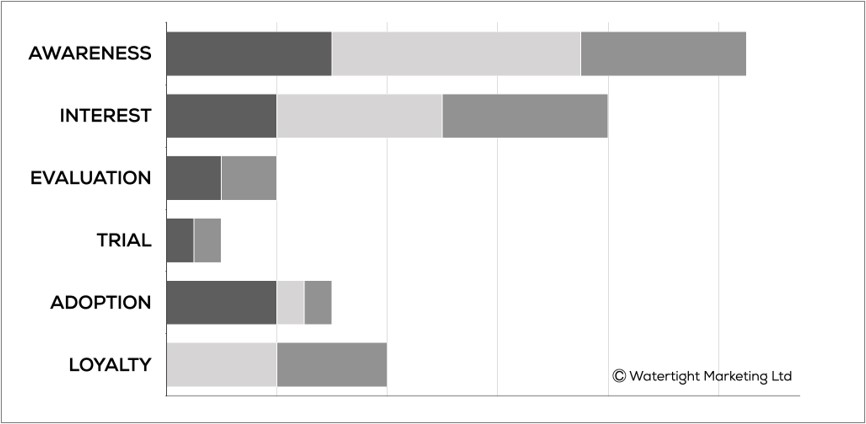Reading Time: 10 Minutes
“A marketer’s relationship with the FD is key. They can test your plan, help develop a metrics dashboard and facilitate budget conversations. However, it’s not a given that your FD will be on-board with marketing. So how can you gain their buy-in and enthusiastic support?” ~ Rachael Wheatley, Managing Director | Watertight Business Thinking
Listen to the session podcast here
51 -minute roundtable discussion on how to get your FD onboard and loving marketing.
When we started working with one client, they had a marketing budget of 0.25% of their revenue. That’s low by any standards and was for a whole variety of reasons. Right from the start of our engagement and over the two years that we worked with them we included the FD in our discussions. At the point when we were asking in a Board meeting for a 400% increase in their marketing budget, the FD was fully aware of the plan, what that would be spent on and why. His response was: is that enough? And that, for us, demonstrated both he was fully on-board with marketing and actively supportive.
Why might FDs not like marketing?
We kicked off with a brief discussion around why FDs might be a bit sceptical of marketing, or perhaps not think of us as well as they could:
- Not showing return on investment or explaining that results depend on multiple touches and can run across a long time-horizon;
- Use of marketing jargon that immediately puts up barriers;
- Not explicitly talking about budgeting and measurement and what an FD can expect in terms of success at each stage of the customer’s buying journey;
- Not talking through the plan with them;
- Misunderstanding of what marketing is (and therefore thinking it’s about spending loads of money without being mindful of the bottom line).
Jonathan Gaunt: “There’s also the element of marketing jumping in and talking about the customer persona; there’s a real opportunity to get finance involved at an early stage and understanding marketing more, and saying, this is what a customer looks like, how long the buying cycle is, and being able to track that through, what is the revenue over a period of time.”
Marketing and finance can be too separated and siloed and not working together.”
Rachael Wheatley: “Yes, bringing finance people into the strategic marketing conversations brings huge value. And, a different perspective.”
Dan Bond: “Marketers need to work harder on financial literacy; that’s a really important thing and probably the biggest gap I see when working with younger marketers – how to do budgeting, forecasts and cashflows. It’s the first thing I did when I joined my current business and it immediately got the finance people on-side. I think analytics literacy as well is important; people don’t always understand how that works.
“I also think the alignment with sales and customer teams is really important. Our job is more happy customers in our business. So aligning with sales and customer service so you can connect everything together. That makes you look like a valuable partner in the business.”
Jonathan Gaunt: “I’m glad you mentioned existing customers. All too often people associate marketing with new business, and businesses can be too obsessed with that. There’s a big role for marketing to play to support happy customers – reduce attrition, increase the average value of customers.”
Three common gaps
Picking up on some of the points made earlier, we see three big gaps.
1. Do you speak the same language?
What marketing says and what finance hears might be different things. Where marketing might say:
“We want to create a really valuable piece of content, printed and sent to key contacts and shared widely on social media to get our advocates engaged.”
Finance might hear:
“We’re going to spend a pile of cash messing around with stuff we think is fun without any impact on the bottom line.”
Be careful with marketing jargon that others may not understand. A good way to avoid this is to involve finance in the plan early on, seek their views. Any jargon can be explained along the way. Good, strategic finance people will ask insightful questions and help test your plan and make it more robust.
2. Are your metrics missing the point?
Our metrics are sometimes not demonstrating what we want them to. If you’re collating data that shows the number of downloads, how many existing and new clients attended your webinar or the sources of those interactions, in isolation they only tell you about volumes.
A more relevant and insightful way to present metrics are if they’re also related to a customer’s progress through the buying journey.
Jonathan Gaunt: “Doing that also shows the time period across which the buying journey occurs and helps make the point that perhaps you don’t want to switch off a particular marketing activity which isn’t yet showing results because they will only show up later.”

3. Is your budget linked to outcomes?
Since one of the things FDs would like to see more of is showing return on investment, linking budgets to outcomes is a good way of doing that. It’s especially powerful if you create a visual budget (See: Watertight Marketing, Chapter 9). If you ensure your FD knows the steps in a buying journey and the desired effect of the marketing you’re putting in place, it becomes easier for others to see the rationale behind the plan.
Include a time budget as well as the usual money budget. This is particularly important for strategic projects and marketing that can be done in-house without spending actual money. It can help you make decisions about which tools to use to release time for you to spend on other things or it provide insight into how much time some marketing activities take and whether that’s a good use of your time.

We recommend including a time budget for two reasons.
1. It shows what skills and knowledge you have in-house that saves you having to use and pay for external suppliers.
2. It demonstrates how much time some marketing takes! It’s also a useful check and balance to ensure you’re spending the time where you need to, commensurate with your plan.
See blog: How to get buy-in to your budget
What gets in the way of a constructive relationship with your FD?
Rachael Wheatley: “Lack of data can be a problem. Without it you can’t show much in the way of success or results. My experience is that at best it’s usually an incomplete picture.”
Peter Baynes: “Not having the financial understanding. Not having the right numbers to talk to the finance team about – the cost of acquiring a customer, their lifetime value. A lot of that information can be found from accounts department.
There’s also the problem of talking two languages – marketing and finance and neither of them understanding what each other is talking about!”
Jonathan Gaunt: “I think it’s the other way round; as a finance expert we need to become more marketing literate. Sometimes it’s about how we both take part in the journey and play to our strengths. How do we collect information once and then use if for multiple purposes – if we can meet in the middle, there’s so much more opportunity for being successful.”
Peter Baynes: “Exactly. Often marketers are only looking at data from the CRM but of course you can get information from accounts. So your dashboard should include information from both.”
Jonathan Gaunt: “It’s more than that – it’s also how you join these all up. For me, it’s what does the perfect system look like so you can track it all the way through and make different systems talk to each other. That’s the utopia I’m working towards – there’s not enough effort that goes into trying to make this happen and asking for the right information that would be useful.”
Dan Bond: “The friction is that meeting between a world of rigour and lack of rigour. Marketing people need to think more about having rigour around finance and analytics. Also we work in a world of shades of grey and missing information – that’s just the way it is. We can’t attribute or track all of the touchpoints.”
Kerry Turney: “I work for a small business and we don’t have a finance person. The MD has that role. So my big challenge is getting time with him. I go to him for approval of spend for individual activities or tools. I don’t know how much is budgeted for marketing overall – not even sure this exists.”
What will help in this instance is for the marketer to put together an overall budget that is linked to the people and agreed with the MD. It will save time on getting approvals tool by tool and provide certainty and boundaries for the marketer. It also gives the marketer some control– it’s then their decision about using this tool or that activity to achieve the plan.
What’s worked for you to get your FD on-board – even loving marketing?
Dan Bond: “Financial literacy, and being really proactive about doing the budgeting and cashflow. Having a regular meeting with finance team on a monthly basis, where we go through everything and make sure they’re happy with what we’re doing and the way we’re doing it. Making them a partner, making sure they can see we produce reports that are internally public. So everyone can see our marketing analytics, everyone can see our performance. We’ve tried to use some measures to track outputs or activity over time, so we can see what’s worked.”
Peter Baynes: “Learning the language, being able to show financial outcomes and implications of activities. And it’s building personal relationships – a cooperative approach.”
Jonathan Gaunt: “I agree, it’s all about relationships. Someone has to make the first move to understand and see things through the other’s eyes. So why isn’t it you (marketing or finance)? If people are talking and communicating, then you can understand the frictions and chip away to overcome them.
The other thing I would add is documentation. It’s important to write things down and be able to refer back to it. It also gives you some form of history that you can build on – avoids starting a blank sheet of paper when you might have spoken about it before. It helps you to move faster and if there are changes of people along the journey over time, you have something to go back to and they can pick things up more easily.”
Peter Baynes: “A lot of marketers put a lot of effort into running activities, but then forget to reflect on them. So write it down so you can refer back to it. Then if you share it with finance or other teams, you’re getting buy-in and educating people in what the results of these activities are and your thoughts about improvements.”
Rachael Wheatley: “That’s a good point. It’s beholden on us to look at how to make activities successful and best value for money. For instance, not just organising a brilliant event, but how do we follow-up?”
Dan Bond: “The time horizon comes into view here as well. There’s the immediate results and opportunities but when we look back at that event in a year or two more things may have happened. We have all that data on our CRM system.”
Watertight Wisdom
What’s worked for us
Ideas from around the room about what a business leader needs to know and how you might change the situation if you needed to:
- Learn the language of finance – a good place to start is something like a finance for non-finance managers.
- Measure volume and progress – only showing volumes is missing the point.
- Link budget to outcomes – it’s a better way of showing where and why you’re spending the money and will change the conversation from “cost” to “investment”. If there is no budget in your business, take the lead and build one, with the finance team.
- Share the plan, involve finance early in its development – they will add real value, be then fully conversant with your aims, the what and the way, and be able to put the budget in the context of the plan.
- Embrace accountability and responsibility – if you’re in marketing you need the responsibility for the budget and accountability for what you then do for it.
- Meet in the middle – take a cooperative approach and use each others’ strengths. What you’ll end up with will be more robust, rigorous and commercial.
- Try and connect different systems – it is often a utopia but the more connected the systems are and the more data you can get from those different systems, the fuller picture you’ll have. Work with finance to build this into a dashboard of key success indicators.
- Build the relationship – have regular meetings between marketing and finance to nurture communication and understanding.
What would you add to our list? Do let us know your thoughts.
To join the conversation at our next Watertight Wednesday marketing roundtable you can sign up here. We’ll be having a chin-wag about how resourcing and recruiting to build a brilliant marketing team.

Rachael Wheatley
Managing Director, Watertight Thinking
Rachael brings over 30 years’ of marketing experience, with a particular focus on building and developing effective marketing teams that are able to act as a strategic driving force across an organisation. She has worked with Watertight since 2014 as a Master Practitioner and joined the business as MD in 2022.



